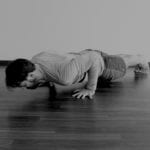Kids love doing cartwheels. Or at least trying to do them. But most adults would probably say they’re too big and heavy now to try something like a cartwheel.
“It’s not worth the risk.”
–Adulthood
But the truth is, kids love cartwheels for the exact reasons that make them great for adults to learn (or re-learn).

Once upon a time, this may have been no big deal, but for most adults it can seem very daunting
It’s not just that they’re fun to do. Cartwheels are a surprisingly great way to assess and improve key areas of strength and mobility, as well as overall coordination and agility.
And that’s actually why kids love them. We’re wired to enjoy challenges like that.
In this article, you’ll learn how to safely do a cartwheel (even if it’s been 20+ years since you’ve tried).
Thanks to @gmbfit I have finally learned to do a cartwheel as a 37 year old father of 3. The older two are now insisting that I teach them how. Time to start them on some beginning monkey
— Reid Evans (@ReidNEvans) June 25, 2019
And you’ll also learn:
- How training for the cartwheel will improve your strength, flexibility, and motor control
- Why fear is the biggest thing holding people back from doing cartwheels as adults, and how to address that
- Additional exercises that will help round out your cartwheel practice so you’ll be doing perfect cartwheels (and a whole lot more) in no time
- Advanced variations you can work on once you’ve got your standard cartwheel down
Anatomy of the Cartwheel – What Will it Take for You to Own This Skill?

It takes a lot of coordination to land a solid cartwheel.
As much as a lot of kids make the cartwheel look like an easy and passive move, there’s actually quite a lot that goes into moving your body from a standing position to an upside down position and back again.
Without the right coordination of movements, many people wind up either plopping over or going in the wrong direction.
You’ll see in the tutorial below that I talk about making an imaginary line (or a real one, if that helps you visualize where you’re going) that you’ll try to land on. In order to do that, you’ll need your body to work together:
- Legs – Your lead leg is going to point in the direction you want to go. So if you want to land on that line, you’ll plant your front foot on the line, pointed straight toward the other end of the line.
- Hands – You’ll start with your lead hand (same side as the lead foot) up in the air, with the palm pointed in the same direction as your lead foot. The back hand will be out to the side.
- Upper and Lower Body – You’ll keep your upper body and lower body in the same vertical plane to swing your legs up and over, and land on that straight line.
Of course, in order to make all those pieces work together, you’ll need a combination of strength and flexibility in the wrists, hips, and torso. And you’ll need a good amount of motor control to be able to make the movement smooth and controlled.
Why is it So Hard to Learn Cartwheels as an Adult?
Maybe you’ve tried to learn to do a cartwheel in the past few years and didn’t have any luck, or maybe you’ve just always assumed you couldn’t do it.
Why does it seem so hard to learn this as an adult?
Kirsty Grosart, talks about this same issue in regards to learning handstands as an adult – and it’s really the same concept. She says it comes down to three main challenges:
- Adults have much larger bodies than children, which are simply more difficult to maneuver.
- Adults tend to have far less flexibility than children do naturally.
- While children tend to be fearless, adults have a certain amount of fear associated with being upside down and throwing their bodies around.
So there are really two parts to address: the physical challenge of limited mobility and strength, and the mental challenge of the fear many people have with a skill like the cartwheel.
Ironically, the best way to address these challenges is by… practicing cartwheels.

Surprise, surprise! The best way to get better at cartwheels is to practice cartwheels.
The progressions I’ll show you in a minute remove much of that fear factor you might otherwise experience. Instead of jumping up and trying to throw your legs over your head, and hoping you land without hurting yourself, you’ll start with very small steps that help you ease into the feeling of being upside down.
Plus, as you work on these progressions, you’ll start building up strength, flexibility, and control throughout your body, which will not only make cartwheels easier but also any other skill you want to learn.
Still, some people are particularly tight or have limited strength in certain areas of their bodies.
If you’re one of those people, I’ll go over some additional exercise recommendations below, right after the detailed cartwheel tutorial. Using these exercises in addition to your cartwheel practice will help you get the maximum benefits from this fun and challenging skill.
Step-by-Step Cartwheel Tutorial
| Progression | Details |
|---|---|
| Progression #1 | • Start by drawing an imaginary (or real) line as your point of reference • Step off the line at an angle • For this variation you'll move in a 'V', placing one hand on the line, then the other, then letting your legs follow so that they land at an angle on the other side of the line • Don't worry about bringing your legs up too high, we're just working on getting you comfortable with having your body "upside down" and coordinating your movement between the hands and feet |
| Progression #2 | • For this variation, you'll start on the line (rather than off to the side), with your lead leg pointing forward • Place one hand down, then the next, and then jump your legs over to the other side • Don't worry about landing on the line as much as making sure your legs do not wind up crossed |
| Progression #3 | • For the last progression, focus on starting and landing on the line • Over time, work on getting the legs as straight as possible as you go over to the other side |
Still Having Trouble? These Three Areas Are Probably Holding You Back
Many people have restrictions throughout their bodies that make it difficult to get as much as possible from the cartwheel.
If you feel you cannot move with ease in this skill, even after working on the first couple of progressions for a while, you most likely have issues in the following areas.
1. Tight and/or Weak Wrists
Most of us are not used to putting weight through our hands, so the wrists can use some additional conditioning to get them moving well and get them strong enough to support your weight comfortably.
In our full tutorial on the wrists, you’ll find three videos and a whole bunch of exercises that will help you make your wrists flexible and strong, but here’s one of those videos to get you started:
Do 3 sets of 10-12 reps of each of those exercises. These can be done daily until you start to feel more strength and mobility in your wrists.
2. Limited Side Bending Motion
As you move closer to the straight line cartwheel, being able to sidebend properly is going to be more and more important. And just like with the wrists, this is an area that is quite restricted for many people simply because we don’t do it much.
To improve sidebending we’ll use two of my favorite stretches, the triangle pose and the half pancake.

- Triangle Pose – This is a pose from Hatha Yoga that really tackles the sidebending needed for the full, straight line cartwheel. Start with your knees bent so you can reach the floor, and over time work on straightening the legs.
- Half Pancake with Sidebend – This one will target sidebending as well as hamstring stretching. Start by dropping your elbow down to the inside of your straight leg, then focus on rotating the chest up to the ceiling.
Move in and out of each stretch 10 times, then hold the stretch for 15-30 seconds on the last repetition. You can do these daily until you start to feel more comfortable with sidebending.
3. Tight Hips
Pretty much everyone these days has tight hips, and restrictions in the hips can definitely make it difficult to get the full range of motion needed for a straight line cartwheel.
We have a full tutorial on hip mobility, but for the cartwheel in particular, the pancake is a great stretch to practice.

Don’t worry if you can’t bring your chest flat to the floor like I’m demonstrating in the picture – if you can do that, your hips are already quite flexible! I’m just showing you what the full position looks like.
Instead, here’s what you should be working on:
- Start by sitting up with your legs as wide as you can possibly go. If that’s not very wide, don’t worry – just start where you can.
- Keep your back straight and lean forward. If you can’t place your hands on the ground without rounding your back, then have a stool/box/chair in front of you for support.
Move in and out of the stretch 10 times, and then hold the stretch for 15-30 seconds on the last repetition.
What Comes Next?
Once you’ve got the cartwheel down, you have a lot of options for skills you can work toward.
The cartwheel is the start of a concept I like to call the “push and lift,” where you’re pushing off of one leg to lift the other leg up and over. This can lead to skills such as:
One Arm Cartwheels
Here you can see GMB Trainer Eduardo demonstrating how you can start working on taking one hand out of the mix with the cartwheel.
Butterfly Kicks
Here’s Eduardo doing the butterfly kick. This is an advanced movement, so it’s okay if you’re not quite ready for this one.
Aerials
This is also called the “no hand cartwheel” and it’s a good combination of the push and lift concept, and the skills gained from practicing the one arm cartwheel. Here you can see Eduardo showing the aerial in action.
More Strength and Agility Means More Fun
Having the physical attributes to bust out a cartwheel whenever you like means a lot more than just being a “fit person.” It means you’ve built a certain level of freedom of movement and body control.
And that means you can do more fun stuff.
As you improve your strength and agility, you open up new possibilities in everything you do with your body. Whether you’re into martial arts, action sports, outdoor adventures, or any other activity, you find yourself suddenly capable of better performance and taking on new challenges.
That’s why we created our free Bodyweight Circuit workout routine.
It’s an easy-to-follow video routine (including variations for any ability level) for building strength throughout your body. But it also includes movements that build the mobility and body control you need for agile movement.
That way you can build the attributes you need not just for cartwheels, but for all the activities you love.
Build Full-Body Strength and Agility
Make your body more stronger and more capable of cartwheels and much more with our free Bodyweight Circuit video routine.






